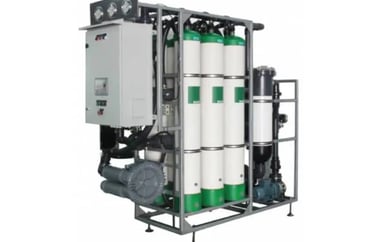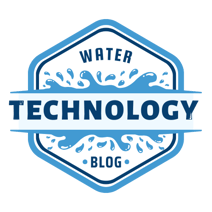Designing a Water Treatment Plant for Low-Turbidity Water Supply to 80 Households
Providing clean, safe drinking water is a cornerstone of public health. This blog post outlines the design of a water treatment plant tailored to treat source water with turbidity ranging from 2–10 NTU (Nephelometric Turbidity Units) to supply potable water to 80 households. The focus is on achieving low turbidity, effective disinfection to eliminate pathogens like Giardia and Cryptosporidium, and meeting World Health Organization (WHO) drinking water standards. We’ll dive into the treatment process, with a particular emphasis on the disinfection setup, to ensure the water is safe and reliable for domestic use.
WATER PURIFICATION
5/26/20255 min read


Step 1: Understanding Water Quality and Demand
Source Water Characteristics
Turbidity (2–10 NTU): This low turbidity range indicates relatively clear water with minimal suspended solids (e.g., silt, clay, or organic matter). Microfiltration is ideal for this range, as it efficiently removes particles in the 0.1–10 µm size range without rapid membrane fouling.
Pathogens of Concern: Giardia and Cryptosporidium are protozoan parasites that can persist in water sources, even at low turbidity. Both are resistant to chlorine disinfection, requiring robust physical removal (e.g., filtration) or advanced disinfection methods like UV treatment.
Target Standards: The treated water must meet WHO guidelines: turbidity <1 NTU (ideally <0.5 NTU), no detectable pathogens, and compliance with microbial safety standards (e.g., <1 CFU/100 mL for E. coli).
Water Demand Estimation
Assuming 80 households with an average of 4 people per household and a per capita water consumption of 150 liters/day (for drinking, cooking, and hygiene):
Total daily demand = 80 households × 4 people × 150 L/day = 48,000 liters/day (48 m³/day).
Accounting for 20% losses (e.g., distribution, treatment inefficiencies), the plant should process 57.6 m³/day (rounded to 60 m³/day for design).
Step 2: Treatment Process Design
The treatment process is streamlined for low-turbidity water, focusing on microfiltration for particle and pathogen removal, followed by a robust disinfection system to address Giardia, Cryptosporidium, and other microorganisms. Below is the proposed treatment train:
1. Pre-Treatment: Screening
Purpose: Remove large debris to protect downstream equipment.
Method: A coarse bar screen or mesh filter (1–5 mm) removes leaves, twigs, or other large particles.
Considerations: Low turbidity (2–10 NTU) typically eliminates the need for coagulation/flocculation, reducing chemical use and sludge production.
2. Microfiltration (MF)
Purpose: Remove suspended solids, bacteria, and protozoa (Giardia and Cryptosporidium) responsible for turbidity.
Effectiveness for Giardia and Cryptosporidium:
Giardia cysts (5–15 µm) and Cryptosporidium oocysts (3–7 µm) are effectively removed by microfiltration membranes with pore sizes of 0.1–0.2 µm, achieving >4-log removal (99.99%) for both pathogens, per EPA and WHO guidelines.
Microfiltration’s physical barrier ensures consistent removal without reliance on chemical disinfection, critical for chlorine-resistant protozoa.
Membrane Specifications:
Pore size: 0.1–0.2 µm.
Material: Polymeric (e.g., PVDF or PES) or ceramic for durability.
Configuration: Hollow fiber modules for high surface area.
Design Parameters:
Flux rate: 50–100 L/m²/h, conservative to minimize fouling.
For 60 m³/day (2.5 m³/h), assuming a flux of 75 L/m²/h, the required membrane area is 33.3 m².
Backwashing: Every 30–60 minutes with air or water to maintain performance.
Chemical cleaning: Weekly or biweekly with sodium hypochlorite or citric acid.
Advantages: Produces water with turbidity <0.1 NTU, removes >99.9% of bacteria and protozoa, and is simple to operate for small systems.
Maintenance: Membrane replacement every 5–10 years, depending on water quality and usage.
3. Disinfection Setup
Disinfection is critical to ensure the water is free of residual pathogens, particularly viruses (which may pass through microfiltration) and to provide protection in the distribution system. Given the need to address Giardia and Cryptosporidium, a dual disinfection approach combining UV disinfection and chlorination is recommended for redundancy and comprehensive pathogen control.
UV Disinfection
Purpose: Inactivate Giardia, Cryptosporidium, and viruses.
Effectiveness:
Giardia: Requires a UV dose of ~10 mJ/cm² for 4-log inactivation.
Cryptosporidium: Requires ~12 mJ/cm² for 4-log inactivation.
Viruses: Higher doses (40–60 mJ/cm²) ensure >4-log inactivation of most viral pathogens.
Design:
UV dose: 40 mJ/cm² (standard for drinking water, per EPA’s UV Disinfection Guidance Manual), ensuring robust inactivation of protozoa and viruses.
Flow rate: 2.5 m³/h (60 m³/day).
System: 1–2 UV reactors with low-pressure mercury lamps, sized for 2.5 m³/h.
Power: ~0.02–0.05 kWh/m³, or ~1.2–3 kWh/day for 60 m³.
Advantages: Chemical-free, highly effective against chlorine-resistant Giardia and Cryptosporidium, and no formation of disinfection byproducts.
Maintenance:
Lamp replacement: Every 12–18 months.
Quartz sleeve cleaning: Monthly to prevent fouling.
Monitoring: UV intensity sensors to ensure consistent dosing.
Chlorination
Purpose: Provide residual disinfection in the distribution system to prevent regrowth of bacteria (e.g., E. coli).
Effectiveness:
Giardia: Partially effective (requires high CT values, e.g., 100–200 mg·min/L at 20°C).
Cryptosporidium: Ineffective due to high chlorine resistance.
Chlorination is included for residual protection against bacterial regrowth, not as the primary defense against protozoa.
Design:
Chlorine dose: 0.5–1 mg/L to achieve a residual of 0.2–0.5 mg/L after 20–30 minutes contact time.
System: Dosing pump with sodium hypochlorite (liquid chlorine) or calcium hypochlorite.
Contact tank: 2–3 m³ (30-minute contact time at 2.5 m³/h).
Advantages: Provides residual protection in pipes, critical for small community systems with potentially long distribution lines.
Maintenance:
Regular chlorine stock replenishment.
Monitoring: Daily residual chlorine testing using portable analyzers.
Disinfection Strategy
Primary: UV disinfection ensures Giardia and Cryptosporidium inactivation, addressing their chlorine resistance.
Secondary: Chlorination provides residual protection for distribution, targeting bacteria and ensuring microbial safety to the tap.
Monitoring: Regular testing for Giardia and Cryptosporidium (e.g., quarterly sampling) and continuous monitoring of turbidity (<0.5 NTU) and chlorine residual (0.2–0.5 mg/L).
4. Post-Treatment and Storage
pH Adjustment: Adjust pH to 6.5–8.5 using lime or sodium hydroxide to prevent pipe corrosion.
Storage: A 60 m³ storage tank (24-hour capacity) ensures consistent supply during peak demand or maintenance.
Distribution: Pumping system with corrosion-resistant pipes (PVC or stainless steel) to deliver water at 1–2 bar pressure.
Step 3: Plant Design and Infrastructure
Capacity: 60 m³/day, with modular design for scalability.
Footprint: ~100 m² for treatment units, storage, and control room.
Power Requirements:
Microfiltration: 0.1–0.2 kWh/m³ (~6–12 kWh/day).
UV disinfection: 0.02–0.05 kWh/m³ (~1.2–3 kWh/day).
Total: ~10–15 kW, achievable with grid power or solar panels.
Key Equipment:
Microfiltration unit: 35–40 m² membrane area.
UV system: 2.5 m³/h capacity, with backup lamps.
Chlorination system: Dosing pump and 2–3 m³ contact tank.
Control system: PLC for monitoring flow, turbidity, UV intensity, and chlorine residual.
Step 4: Operational and Maintenance Considerations
Staffing: 1–2 operators for daily monitoring and maintenance.
Maintenance:
Microfiltration: Backwashing (hourly), chemical cleaning (weekly), membrane replacement (5–10 years).
UV: Lamp replacement (12–18 months), sleeve cleaning (monthly).
Chlorination: Chlorine stock replenishment (weekly), pump maintenance (yearly).
Waste Management: Backwash water recycled or treated for disposal (low volume due to low turbidity).
Monitoring:
Inline turbidity meters (<0.5 NTU target).
UV intensity sensors and chlorine residual analyzers.
Periodic microbial testing for Giardia and Cryptosporidium.
Step 5: Cost Estimation
Capital Costs:
Microfiltration system: $20,000–$30,000.
UV disinfection: $5,000–$8,000.
Chlorination system: $2,000–$4,000.
Storage and piping: $10,000–$15,000.
Total: ~$37,000–$57,000.
Operational Costs:
Power: $1,000–$2,000/year.
Chemicals (chlorine, cleaning agents): $500–$1,000/year.
Maintenance and labor: $2,000–$3,000/year.
Total: ~$3,500–$6,000/year.
Cost per Household: ~$6–$9/household/month over 20 years, affordable for small communities.
Step 6: Pathogen Removal Assurance
Giardia and Cryptosporidium: Microfiltration provides >4-log removal, and UV disinfection adds >4-log inactivation, ensuring negligible risk of protozoan contamination.
Other Pathogens: Microfiltration removes >99.9% of bacteria, while UV and chlorination address viruses and residual bacteria, meeting WHO microbial safety standards.
Reliability: The dual disinfection approach (UV + chlorination) ensures robust protection, even during maintenance or power outages (with backup systems).
This water treatment plant, designed for 80 households with source water of 2–10 NTU turbidity, leverages microfiltration and a dual UV-chlorination disinfection system to deliver safe, potable water. The system effectively removes Giardia and Cryptosporidium through microfiltration’s physical barrier and UV’s inactivation, while chlorination ensures residual protection. The compact, cost-effective design meets WHO standards, supports sustainability with low energy use, and can be scaled for future needs. For communities seeking reliable drinking water solutions, this approach balances efficiency, safety, and affordability.
